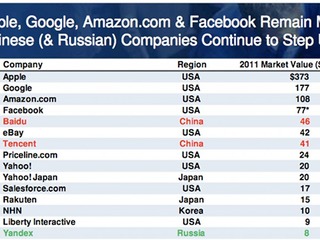Smart infant monitoring company Owlet partners with Wheel
Wheel clinicians will be able to prescribe Owlet's BabySat, which monitors oxygen and heart rate
Read more...
Every year, KPCB partner Mary Meeker releases her Internet Trends report, with insights that capture the trends in Internet and mobile. It has become an important document for looking at how the Internet is evolving, and what to expect in the coming years.
The latest report was put out on Wednesday and here are some of the key takeaways:
As you know, there are a lot more people using the Internet now than in 1995 (20 years ago). Back then it was less 1% of the world population, now it is 39% or 2.8 billion people.
Twenty years ago, I was only nine years old, the same year my family first signed up for AOL dial-up Internet. So, while the early pioneers were starting to shape the Internet, I was just starting to notice that girls existed. Snapcht Founder and CEO Evan Spiegel was 5 years old, and likely creating drawings, giving them to his parents... and then taking them away. And remember Nick D' Aloisio, the young techie who sold his artificial intelligence company Summly to Yahoo for $30 million in 2013? He was born in November of that year. So he was basically swimming around in his mom's belly.

The same goes for mobile users, which has penetrated 73% of the world market, which represents 5.2 billion people.

Remember what phones used to look like back then? I remember my mother carrying around one that looked like this:

Even though they were already getting a bit smaller. Looking at these makes you want to say, "Hey! I can't watch videos on that! How am I supposed to swipe the screen? Where are my apps?"

But now both new Internet users, and new mobile phone users, are starting to slow due to that increased penetration. In 2014, new Internet users grew by 8%, down from 10% in 2013 and 11% in 2012.
New mobile phone users grew by 23% last year, down from 27% the year before and a startling 65% in 2012.

Still, more users means that traffic is still increasing rapidly, especially when it comes to video, which represented 64% of all the Internet traffic in 2014, and 55% on mobile.
 Advertising
Advertising
Total Internet ad spend was $50 billion, of which $13 billion was on mobile. Meeker says she remains optimistic about growth, and that she sees a $25 billion opportunity in the United States.
 Messaging
Messaging
2014 was a big year for messaging and Meeker identified the top apps in the space, with the number of monthly active users and messages spent per day.
The leader is still WhatsApp, with 800 million MAUs and 30 billion messages sent every day. Facebook Messenger comes in second, with 600 million MAUs. Not accounting for overall, that gives Facebook has 1.4 billion people using one of its messaging apps every month. That's... kind of insane.
 Asian countries, she said, are leaders in this space, and companies from around the world are implementing their playbooks, to apparent success.
Asian countries, she said, are leaders in this space, and companies from around the world are implementing their playbooks, to apparent success.
User generated content
Social networks are evolving to include more user-generated content, rather than just aggregating already existing content from across the Web.
Facebook has been particularly successful with it comes to video in this regard. with four billion views a day, which is up four times what it was just six months ago.

And on Twitch, which was recently purchased by Amazon, the number of videos broadcast every month rose 83% year to year, reaching 11 million.
 Soundcloud, Wattpad and even Airbnb, with its user-generated reviews, have also seen significant increases.
Soundcloud, Wattpad and even Airbnb, with its user-generated reviews, have also seen significant increases.
Millenials
Here's something obvious: millenials love their smarphones, with 87% having it on them at all times (guilty!) 80% reaching for their smartphone first thing in the morning (guilty!), 78% spending more than two hours on it (guilty!) and 60% believing that, in five years, everything will be done on a mobile device (eh... no).

Millenials are also the largest generation in the workforce now, going from just 6% in 2000 to 35% in 2015.

And they are not perceived very well by hiring managers, who see them as narcissitic, money driven and not team players, but also creative, adaptible and open to change.

Drones
Drones are quickly becoming big business, with the number of units shipped expected to hit 4.3 million this year, an increase of 167% from 2014, and with revenye to hit $1.7 billion.

And the United States is going to lead that charge, with 35% of the global market, compared to just 15% for China.

The way we work
The workforce is rapidly changing, as the percentage of people that actually make things continues to decline.

And knowledge-based jobs continue to rise, doubling since 1983.

There are now also more freelancers than ever before, with 53 million people, or 34% of the population, identifying as such.

India
India is seeing an explosion in Internet connectivity, with 232 million users making it the world's third largest market, behind the United States and China.
 It is the second largest market for Facebook and LinkedIn, and the fastest growing for Twitter.
It is the second largest market for Facebook and LinkedIn, and the fastest growing for Twitter.

(Image source: josephrosenfeld.com)
Wheel clinicians will be able to prescribe Owlet's BabySat, which monitors oxygen and heart rate
Read more...Amish Jani, Founder and Partner at FirstMark, joined the company's Board of Directors
Read more...The report outlined four areas as a guide to help startups to sell into these systems
Read more...


